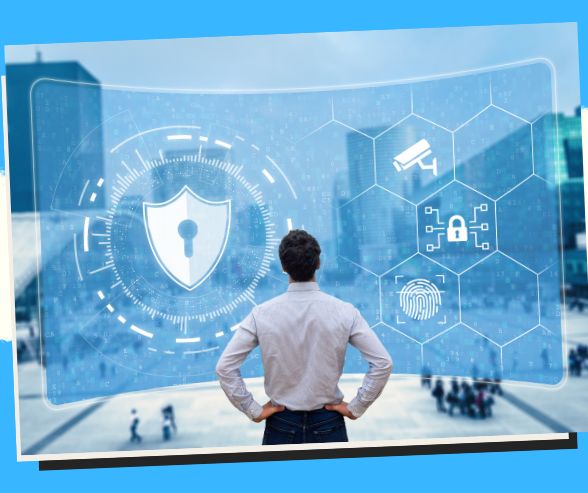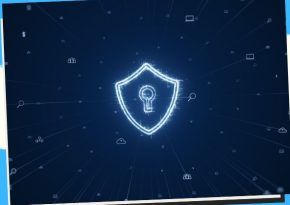
Unlocking Digital Immunity: Your Guide to Cyber Security Fundamentals
Navigate the intricate world of cyber threats with confidence. Learn how cybersecurity fundamentals are your shield against digital vulnerabilities.
Cyber Security Fundamentals: Your Shield in the Digital Realm 

In a world where small business owners, internet marketers, social media sellers, parents, and professionals are intricately woven into the digital tapestry, understanding the fundamentals of cybersecurity is akin to unlocking a powerful shield against modern threats. As we navigate the boundless landscapes of technology, embracing cybersecurity becomes a paramount responsibility for individuals in every walk of life.
The Essence of Cyber Security
At its core, cybersecurity encompasses strategies, tools, and practices designed to protect digital assets from malicious actors, data breaches, and cyberattacks. In a realm where connectivity breeds innovation, cybersecurity stands as the guardian of confidentiality, integrity, and availability in the digital world.
1. Encryption: The Digital Enigma
Imagine encryption as a coded language that only the intended recipient can decipher. This technology plays a pivotal role in safeguarding sensitive information, making it indispensable for small business owners, parents, and professionals. By transforming data into an unreadable format, encryption ensures that even if intercepted, the information remains secure. This practice is a cornerstone of digital communication, from protecting business secrets to maintaining the privacy of family communications.
2. Firewalls: Digital Gatekeepers
Firewalls are the first line of defense in the world of cybersecurity. Just as a castle’s drawbridge keeps intruders at bay, firewalls monitor incoming and outgoing network traffic, filtering out potential threats. Small business owners, internet marketers, and social media sellers can benefit from integrating firewalls into their digital infrastructure, protecting valuable data and systems from unauthorized access.
3. Intrusion Detection and Prevention Systems (IDS/IPS)
For professionals seeking to secure their digital realms, IDS and IPS serve as digital watchdogs. Intrusion Detection Systems (IDS) scan networks for suspicious activities, while Intrusion Prevention Systems (IPS) respond proactively to thwart potential threats. Whether you’re a small business owner guarding customer data or a parent ensuring online safety for your children, these systems act as vigilant sentinels.
4. Multi-Factor Authentication (MFA): The Power of Layers
MFA adds an extra layer of security to digital interactions. By requiring multiple forms of identification before granting access, MFA serves as a formidable barrier against unauthorized entry. Professionals across the spectrum, from internet marketers to parents, can leverage MFA to safeguard their online interactions, ensuring that only authorized parties can access sensitive data or accounts.
5. Security Audits and Penetration Testing: Unveiling Vulnerabilities
Security is a proactive endeavor. Regular security audits and penetration testing are essential for small business owners, professionals, and parents alike. These practices simulate real-world cyberattacks, identifying vulnerabilities that could be exploited by malicious actors. By embracing these assessments, individuals can reinforce their digital defenses and stay one step ahead of potential threats.
6. Security Awareness Training: Empowering Vigilance
In an era where education is a vital armor, security awareness training equips individuals with the knowledge to identify and respond to cyber threats. For small business owners, professionals, and parents, staying informed about phishing tactics, malware threats, and social engineering techniques is crucial. This knowledge empowers individuals to navigate the digital landscape with confidence and vigilance.
7. Endpoint Security: Safeguarding Devices
End devices such as computers, smartphones, and tablets are pivotal in today’s interconnected world. Endpoint security ensures that these devices remain fortified against cyber threats. Professionals, parents, and internet marketers can benefit from this technology by ensuring that each device is protected from malware, unauthorized access, and data breaches.
 Benefits of Understanding Cybersecurity Fundamentals
Benefits of Understanding Cybersecurity Fundamentals
Protects Your Digital Identity
Learn how to safeguard passwords, social profiles, and online accounts.Secures Business Data
Prevent customer data leaks and ensure business continuity.Avoids Financial Loss
Stop fraud, ransomware payments, and unauthorized transactions.Ensures Regulatory Compliance
Meet GDPR, HIPAA, and local data protection laws.Reduces Risk of Cyber Attacks
Spot suspicious activity before it becomes a crisis.Encourages Safe Online Habits
Build a culture of security in the workplace and at home.Enhances Tech Literacy
Become smarter about the tools and platforms you use daily.Builds Awareness Against Social Engineering
Recognize phishing and manipulative schemes.Protects Mobile & IoT Devices
Keep your smart home, phones, and gadgets secure.Boosts Overall Confidence Online
Browse, shop, and interact online with peace of mind.
 Pros and Cons of Cybersecurity Fundamentals
Pros and Cons of Cybersecurity Fundamentals
Pros  | Cons  |
|---|---|
| Basic training is easy to access and understand | May require constant updates and learning |
| Applies to both personal and professional use | Implementation may face resistance from employees |
| Reduces human error in breaches | Not all threats are preventable even with fundamentals |
| Builds a proactive security culture | Can create a false sense of total protection |
| Saves money in the long term | Upfront investments in tools may be required |
| Helps avoid legal consequences | Time-consuming for large organizations |
| Encourages safer work-from-home environments | Over-reliance on tech may overlook human factors |
| Protects brand reputation | May require policy changes and training plans |
| Improves resilience to cyber threats | Needs regular audits to remain effective |
| Prepares teams for real-world security challenges | Can be seen as burdensome by non-technical users |
 Real-World Case Studies of Cybersecurity in Action
Real-World Case Studies of Cybersecurity in Action
- Zoom (2020)
Implemented end-to-end encryption after privacy concerns, rebuilding user trust. - Singapore’s Smart Nation Initiative
Invested in cybersecurity awareness campaigns and digital education. - Maersk Shipping (2017)
Recovered quickly from a ransomware attack due to backups and disaster recovery protocols. - IBM’s “Think” Campaign
Educated businesses globally on cybersecurity basics through storytelling and outreach. - City of Atlanta (2018)
Ransomware crippled city services—highlighting the need for cyber hygiene at the government level. - Google’s Security Key Implementation
Reduced phishing to nearly zero among employees using 2FA keys. - Australia’s CyberSmart Program
Promoted cybersecurity fundamentals in schools, helping raise a digitally aware generation. - Marriott Data Breach (2018)
Exposed need for robust internal controls and regular audits. - Tesla Bug Bounty Program
Rewarded white-hat hackers to report vulnerabilities before criminals exploited them. - LinkedIn Security Updates (2021)
Rolled out tools for users to control data visibility and report scams.
 Key Takeaways for Practicing Cyber Hygiene
Key Takeaways for Practicing Cyber Hygiene
- Use Strong, Unique Passwords
Avoid repeating the same password across services. - Enable Two-Factor Authentication (2FA)
Adds an extra layer beyond just a password. - Recognize Phishing Attempts
Double-check suspicious emails, links, or attachments. - Keep Software & Systems Updated
Patches fix known security vulnerabilities. - Back Up Your Data Regularly
Protects against data loss and ransomware attacks. - Limit Permissions
Only grant access to what’s truly needed for each user or device. - Use a VPN on Public Wi-Fi
Encrypts your data on unsecured networks. - Secure Mobile Devices
Lock with biometrics, install antivirus, and turn off auto-connect. - Be Wary of Unknown USBs & Devices
Malware can enter through hardware as well. - Educate Others
Share what you learn—cybersecurity is a team effort.
 Frequently Asked Questions (FAQs)
Frequently Asked Questions (FAQs)
- What is cybersecurity?
Cybersecurity is the practice of protecting systems, networks, and data from cyber threats. - Who needs to understand cybersecurity basics?
Everyone, from individuals and families to businesses and government employees. - What are common types of cyber threats?
Phishing, malware, ransomware, spyware, and man-in-the-middle attacks. - How do I create a strong password?
Use a mix of uppercase, lowercase, numbers, and symbols; avoid personal info. - What is phishing?
A fraudulent attempt to get sensitive information by pretending to be a trustworthy entity. - How do updates improve cybersecurity?
They patch known vulnerabilities and improve software defense systems. - Is antivirus software still necessary?
Yes, especially paired with other layers like firewalls and 2FA. - What is the role of a firewall?
It acts as a digital barrier, filtering incoming and outgoing traffic. - How do I teach my kids about cybersecurity?
Use age-appropriate tools, games, and discussions to encourage smart habits. - What should I do if I suspect a cyber attack?
Disconnect from the internet, contact IT support, and report to cybersecurity authorities.
Conclusion: Embracing Cyber Security Empowerment
In a digital era marked by boundless opportunities and equally boundless threats, understanding the fundamentals of cybersecurity is no longer a choice; it’s a responsibility. Small business owners, internet marketers, social media sellers, parents, and professionals all share the duty of creating a safe digital environment.
By weaving encryption, firewalls, intrusion detection systems, multi-factor authentication, and proactive assessments into our digital fabric, we build a resilient defense against the ever-evolving landscape of cyber threats. Let us embark on this journey of empowerment, equipping ourselves with the tools and knowledge to navigate the digital realm with confidence, resilience, and security.
 Link Resources
Link Resources
- StaySafeOnline.org (National Cybersecurity Alliance)
- Cybersecurity & Infrastructure Security Agency (CISA)
- Norton Cyber Safety Resources
- Kaspersky Cybersecurity Tips
- Google Safety Center
 Key Phrases
Key Phrases
- Cybersecurity for beginners
- Digital safety tips
- Online security basics
- Cyber hygiene practices
- Phishing email detection
- Two-factor authentication guide
- Protect personal data online
- Mobile cybersecurity tips
- How to prevent data breaches
- Cyber awareness training
 Best Hashtags
Best Hashtags
#CyberSecurityBasics
#OnlineSafety
#DigitalImmunity
#CyberAwareness
#PhishingAlert
#StayCyberSafe
#InfoSec
#CyberHygiene
#DigitalSecurity
#DataProtection
Save/Share this story with QR CODE
Disclaimer
This article is for informational purposes only and does not constitute endorsement of any specific technologies or methodologies and financial advice or endorsement of any specific products or services.
 Need to get in touch?
Need to get in touch?

We appreciate your reading. 
1.) 

Your DONATION will be used to fund and maintain NEXTGENDAY.com
Subscribers in the Philippines can make donations to mobile number 0917 906 3081, thru GCash.
3.) 
4.) 
AFFILIATE PARTNERS

World Class Nutritional Supplements - Buy Highest Quality Products, Purest Most Healthy Ingredients, Direct to your Door! Up to 90% OFF.
Join LiveGood Today - A company created to satisfy the world's most demanding leaders and entrepreneurs, with the best compensation plan today.

 Business, Finance & Technology
Business, Finance & Technology

























